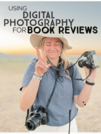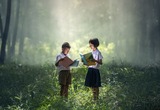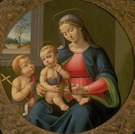Students will be able to create a podcast in which they describe a book and the reasons they recommend that someone should read it.
- Subject:
- Media and Communications
- Material Type:
- Lesson
- Author:
- Utah Lesson Plans
- Date Added:
- 11/02/2021
Students will be able to create a podcast in which they describe a book and the reasons they recommend that someone should read it.

Students will capture their own images to promote or recommend a book from their personal reading. This assignment is designed to blend principles from digital photography, design, and library media standards to demonstrate deeper understanding and critical thinking skills. This lesson plan was created by Andrea Settle then remixed by Melissa Jensen.Image: "Student Photographer" by Melissa Jensen is licensed under CC BY-NC-SA 2.0

Image Credit: Pixabay @sasint Nov. 18, 2016

Students will learn the potential costs and benefits of social media, digital consumption, and our relationship with technology as a society in the three-week lesson. This inquiry based unit of study will answer the following questions:
Essential Question: How can we use science fiction’s ability to predict the future to help humanity?
Supportive Questions 1: What predictions of future development has science fiction accurately made in the past? This can include technology, privacy, medicine, social justice, political, environmental, education, and economic.
Supportive Question 2: What predictions for future development in contemporary science fiction are positive for the future of humanity? What factors need to begin in your lifetime to make these predictions reality?
Supportive Question 3: What predictions for future development in contemporary science fiction are negative for the future of humanity? What factors need to begin in your lifetime to stop these negative outcomes?
(Thumbnail is a screenshot of the OER Commons lesson page, taken 7/26/2022 by Christina Nelson.)

This lesson is designed to help middle school students understand the Fantasy Genre in literature. What makes fantasy different than realistic fiction or historical fiction. They will learn the elements of fantasy and then act out a short 5 minute fantasy using those elements.
The various genres and subgenres are presented to the students using a video and presentation, and use of examples of several fiction, non-fiction, and poetry books. Then, using a mixed-genre set of books, and the notes they took during the presentation, students will identify the genres represented in each set.
The various genres and subgenres are presented to the students using a video and presentation, and use of examples of several fiction, non-fiction, and poetry books. Then, using a mixed-genre set of books, and the notes they took during the presentation, students will identify the genres represented in each set.After students finish reading a book independently, they will use what they learned from the presentation to identify the book's genre in their book reviews for their ELA teacher.
The various genres and subgenres are presented to the students using a video and presentation, and use of examples of several fiction, non-fiction, and poetry books. Then, using a mixed-genre set of books, and the notes they took during the presentation, students will identify the genres represented in each set.After students finish reading a book independently, they will use what they learned from the presentation to identify the book's genre in their book reviews for their ELA teacher.
Introduce middle school students to reading through the use of graphic novels. Students will follow different themes in the novel citing quotes to support the different themes in the book.
In this lesson students will complete a reading survey to Students will become aware of their Reader Identity - reading preferences, habits, strengths, weaknesses, and attitudes.
In this lesson there will be books placed on tables around the library with questionnaires for students to answer in the format of "speed dating" to help students choose a book matching their interests and reading level.
In this lesson students will learn how to present a book talk, and prepare to give a book talk.

In this lesson, students will investigate and identify Renaissance 'movers and shakers' and their contributions. They will conduct research, create multimedia presentations, and design class activities centered around an important Renaissance artist, thinker, and/or scientist. Research resources and student handouts are included in the lesson plan.The lesson is intended to take about 5 class periods of 45 minutes each.The lesson is based on a lesson originally created by Diana Payne and Dirk Sprunt.
Students will be given an introduction to the library layout and how to find books in the library catalog. They will understand strategies for choosing books for independent reading. Students will begin researching the various methods provided by teachers to present knowledge of a book at the end of the school year, why the selected it, and what other books they plan on reading next.